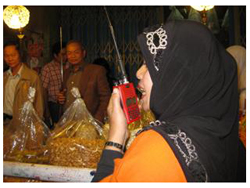Red radio network & live mobile CCTV against bomb threats
 By Lekha kliangklao, Nasuerah Jeha
By Lekha kliangklao, Nasuerah Jeha
A couple of years back when Hat Yai was targeted for repeated bomb attacks by suspected insurgents, a project called the “people’s radio network for the protection of Hat Yai” or the “Red radio network” in short was quietly launched by Lt-Gen Pichet Visaijorn, commander of the Fourth Army Region, to cope with the bomb threat.
The project aims to draw the participation of the town’s people to be on the lookout for suspicious criminal activities or suspected bombs and then report them to the authorities through the CB band 245 MkHtz frequency radio network.
When the project was first launched, all operators of hotels and entertainment places in the city were asked to join the programme. The number of memberships which started at a few hundred has now exceeded one thousand. The network station, formally called Montho Centre is based at the 42nd army region headquarter in the municipal area. Each member was given a call sign.
Lt-Gen Pichet said that since the establishment of the people’s radio network, security in Hat Yai township has improved considerably without a single case of major bomb attack ever since. Also, the number of crimes such as theft, robbery and gang robbery has also reduced, he added.
Similar has also been introduced in the three strife-torn southernmost provinces under a different name “Danger alert, live CCTV”. Rather than relying on radio network as the medium for communication and information dissemination, the project draws on the cooperation of the so-called “four pillar leaders”, namely community leaders, religious leaders, local leaders and natural leaders to help solve the unrest and local problems and also to help in community development.
Yala Governor Krisada Boonrach who recently presided over a training programme for the four pillar leaders said he believes that peace will be finally restored in the far South if all these leaders are genuinely cooperative to solve the problems under the principle, locally known as Hugumpaka, that local people should be allowed to solve their own problems.
Under the principle, a set of rules will be drafted the four pillar leaders in a community which must be followed by all people in the community.
“We can take care of our own problems. Outsiders may not understand some of our problems and, therefore, may not be as good as us in tackling the local problems,” said Muhamad Phumipit, assistant headman of Ban Rae in Tharnto district of Yala.
As such, the four pillar leaders are likened to life mobile CCTV who will help monitor activities in communities and to deal with any problem which may occur.
